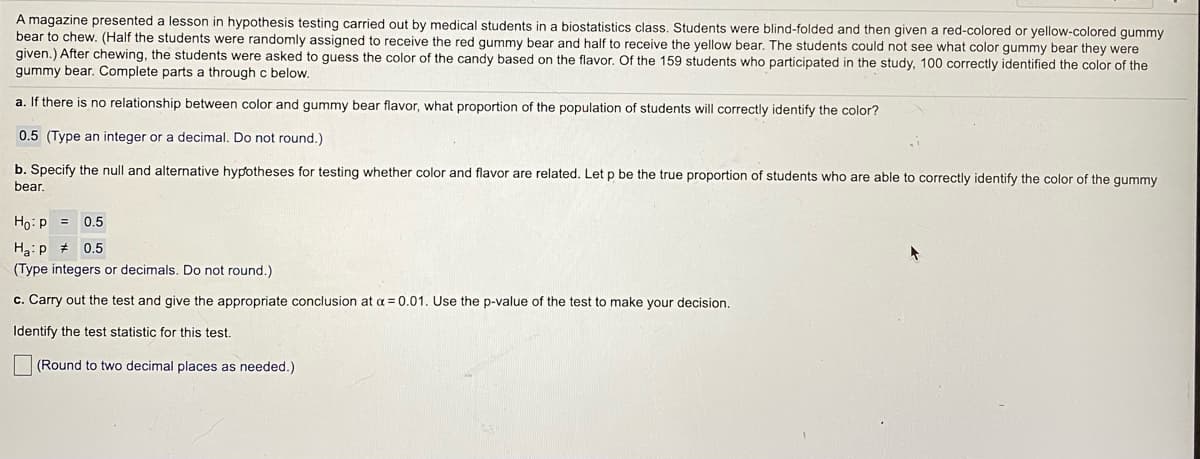A magazine presented a lesson in hypothesis testing carried out by medical students in a biostatistics class. Students were blind-folded and then given a red-colored or yellow-colored gummy bear to chew. (Half the students were randomly assigned to receive the red gummy bear and half to receive the yellow bear. The students could not see what color gummy bear they were given.) After chewing, the students were asked to guess the color of the candy based on the flavor. Of the 159 students who participated in the study, 100 correctly identified the color of the gummy bear. Complete parts a through c below. a. If there is no relationship between color and gummy bear flavor, what proportion of the population of students will correctly identify the color? 0.5 (Type an integer or a decimal. Do not round.) b. Specify the null and alternative hypotheses for testing whether color and flavor are related. Let p be the true proportion of students who are able to correctly identify the color of the gummy bear. Họ: p = 0.5 H:p + 0.5 (Type integers or decimals. Do not round.) c. Carry out the test and give the appropriate conclusion at a = 0.01. Use the p-value of the test to make your decision. Identify the test statistic for this test. (Round to two decimal places as needed.)
A magazine presented a lesson in hypothesis testing carried out by medical students in a biostatistics class. Students were blind-folded and then given a red-colored or yellow-colored gummy bear to chew. (Half the students were randomly assigned to receive the red gummy bear and half to receive the yellow bear. The students could not see what color gummy bear they were given.) After chewing, the students were asked to guess the color of the candy based on the flavor. Of the 159 students who participated in the study, 100 correctly identified the color of the gummy bear. Complete parts a through c below. a. If there is no relationship between color and gummy bear flavor, what proportion of the population of students will correctly identify the color? 0.5 (Type an integer or a decimal. Do not round.) b. Specify the null and alternative hypotheses for testing whether color and flavor are related. Let p be the true proportion of students who are able to correctly identify the color of the gummy bear. Họ: p = 0.5 H:p + 0.5 (Type integers or decimals. Do not round.) c. Carry out the test and give the appropriate conclusion at a = 0.01. Use the p-value of the test to make your decision. Identify the test statistic for this test. (Round to two decimal places as needed.)
Algebra & Trigonometry with Analytic Geometry
13th Edition
ISBN:9781133382119
Author:Swokowski
Publisher:Swokowski
Chapter10: Sequences, Series, And Probability
Section10.8: Probability
Problem 30E
Related questions
Question

Transcribed Image Text:A magazine presented a lesson in hypothesis testing carried out by medical students in a biostatistics class. Students were blind-folded and then given a red-colored or yellow-colored gummy
bear to chew. (Half the students were randomly assigned to receive the red gummy bear and half to receive the yellow bear. The students could not see what color gummy bear they were
given.) After chewing, the students were asked to guess the color of the candy based on the flavor. Of the 159 students who participated in the study, 100 correctly identified the color of the
gummy bear. Complete parts a through c below.
a. If there is no relationship between color and gummy bear flavor, what proportion of the population of students will correctly identify the color?
0.5 (Type an integer or a decimal. Do not round.)
b. Specify the null and alternative hypotheses for testing whether color and flavor are related. Let p be the true proportion of students who are able to correctly identify the color of the gummy
bear.
Ho:p = 0.5
Ha: p # 0.5
(Type integers or decimals. Do not round.)
c. Carry out the test and give the appropriate conclusion at a = 0.01. Use the p-value of the test to make your decision.
Identify the test statistic for this test.
(Round to two decimal places as needed.)
Expert Solution
This question has been solved!
Explore an expertly crafted, step-by-step solution for a thorough understanding of key concepts.
This is a popular solution!
Trending now
This is a popular solution!
Step by step
Solved in 2 steps with 2 images

Knowledge Booster
Learn more about
Need a deep-dive on the concept behind this application? Look no further. Learn more about this topic, statistics and related others by exploring similar questions and additional content below.Recommended textbooks for you

Algebra & Trigonometry with Analytic Geometry
Algebra
ISBN:
9781133382119
Author:
Swokowski
Publisher:
Cengage

Algebra & Trigonometry with Analytic Geometry
Algebra
ISBN:
9781133382119
Author:
Swokowski
Publisher:
Cengage